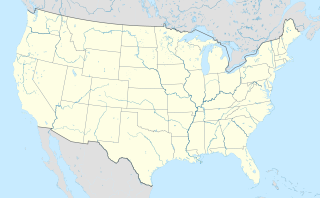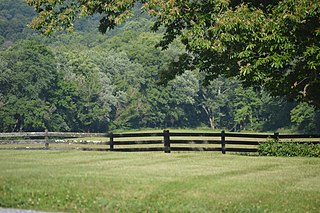
Buildings, sites, districts, and objects in Delaware listed on the National Register of Historic Places:

The Mount Elizabeth Archeological Site, also known as Racey's Tuckahoe, St. Joseph's Novitiate or the Mount Elizabeth Indian Mound is a prehistoric midden and an archaeological site in Jensen Beach, Florida. It is located in Martin County's Indian RiverSide Park, which includes the former Florida Institute of Technology east of Indian River Drive on the Indian River Lagoon. On September 14, 2002, it was added to the National Register of Historic Places.
The Ake Site is a name for a prehistoric archaeological location near the town of Datil in the San Augustine Basin of Catron County, New Mexico, United States. It was listed on the New Mexico Register of Cultural Properties in 1975, and listed on the National Register of Historic Places in 1976. The Ake Site is particularly important for the age and length of its use by prehistoric peoples. It has been dated during the Clovis period between 10,999 BC and 8000 BC, and during the Folsom period between 7999 BC and 5999 BC, making it among the oldest sites in the American Southwest.
Walker Prehistoric Village Archeological Site is an archeological site located near Poolesville, Montgomery County, Maryland. The site is a large Late Woodland village located on Selden Island in the Potomac River. Excavations carried out in the 1930s and 1940s revealed a 40-foot section of a palisade, circular house patterns, shallow oval pits and cylindrical pits, and flexed burials interred in the floors of the houses.

This is a list of the National Register of Historic Places listings in Dearborn County, Indiana.

The Book Site is an archaeological site in Juniata County, Pennsylvania, United States. Consisting of the remnants of a burial mound and a prehistoric village, the site lies on both sides of Camp Resort Road in Beale Township, near the community of Beale.

The Coombe Historic District is a national historic district located at Felton, Kent County, Delaware. It encompasses two contributing buildings and one contributing structure near the town of Felton representing an unusual mixture of archaeological resources, both prehistoric and historic, in combination with two excellent examples of domestic architecture from the 18th and 19th centuries. They are the brick Benjamin Coombe House, built in 1778, and the frame Caldwell House, built about 1872, with their respective outbuildings. It also includes the Hopkins Cemetery, begun in the late-19th century, and three historic archaeological house sites, as well as an area of prehistoric occupation that was listed in the National Register of Historic Places in 1979 as "Area F" in the Hughes Early Man Complex.
The Carey Farm Site (7K-D-3) is a prehistoric Native American archaeological site in central Kent County, Delaware, near Dover. The site, located along the St. Jones River, encompasses what is believed to be a major seasonal base camp from the Woodland Period. Ceramics dating to 200 CE have been found at the site.

The Looney Mill Creek Site is a prehistoric and historic archaeological site near Buchanan in Botetourt County, Virginia. The site, located near the confluence of Looney's Mill Creek and the James River, has evidence of Native American occupation dating as far back as 6000BC, and was the site of the settlement and mill established c. 1742 by Robert Looney, one of the area's first European settlers.
The Hughes-Willis Site is a prehistoric Native American archaeological site in Kent County, Delaware. It is located in Dover, Delaware on the banks of the Little River, and was identified in 1971. The site contains evidence of occupation dating back 5,000 years, with its most significant occupational period being the Middle Woodland Period. Finds at the site include projectile points, and tools for cutting and scraping made of stone. The evidence suggests the site was occupied seasonally, probably sometime in the period between late fall and mid-winter.
St. Jones Neck is a geographic region of eastern central Kent County, Delaware, United States, with a rich prehistory and colonial history. Originally known just as Jones Neck, it is bounded on the west by the St. Jones River, on the north by Little Creek, and on the east by Delaware Bay. The area consists of low rolling hills that do not rise very much above sea level, interspersed with bodies of fresh and salt water. Streams are headed by marshes, and there are tidal marshlands along the bay. The neck has pockets of woodland which are concentrated near the freshwater marshes and tributaries. Land use in the neck is at present predominantly agricultural.
The Wilgus Site is a prehistoric Native American camp site in coastal Sussex County, Delaware, near Bethany Beach. The site is located along a now-inundated tributary of the Indian River, with the main living area of the camp on top of a low knoll. Shell middens and refuse heaps, some as much as 8 metres (26 ft) in diameter, are located down the slopes of the knoll. Evidence of the site indicates it was occupied during the Adena culture during the Early Woodland Period.
The Townsend Site is a major prehistoric Native American site in Sussex County, Delaware. The Late Woodland site includes at least 90 significant features, including numerous burial sites. The site received its first thorough study in 1948, and was the first Late Woodland site in the state to be examined in consultation with professional archaeologists of the Smithsonian Institution, and resulted in the creation of a typology of ceramics found.
Manning Archeological Site is a historic archaeological site located near Cayce, Lexington County, South Carolina. The site contains evidence of prehistoric Indian occupation beginning with the Paleo-Indian period though the historic Indians of the 1700s.
The Island Field Site (7K-F-17) is a major archaeological site in Kent County, Delaware. The site is located in South Bowers, just south of the Murderkill River near where it empties into Delaware Bay. The site was a major prehistoric Native American village site, which was most notable for its cemetery. The site was first identified in the 1920s during road work, and was excavated in the 1950s-60s, after which the area was eventually built up to include a museum. In 1986 members of the local Nanticoke tribe protested the display and removal for research of burial remains at the site.

The Clyde Farm Site (7NC-E-6) is a prehistoric archaeological site in rural New Castle County, Delaware. Its main features are remnants of a pit-house, storage area, and hearth, dating to c. 1000 BCE. Another area where stone tools were produced was also identified during excavations in 1984. The site has been known, and the subject of both amateur and professional archaeological interest, since at least the 1930s. It is described as being located near the fall line of a waterway and also an estuarine area.
7K-F-4 and 7K-F-23 are a pair of archaeological sites in southern Kent County, Delaware, near the town of Milford. Both are Early Woodland Period Native American camp sites, at which ceramics have been found.
The Hughes Early Man Sites are a complex of prehistoric archaeological sites in central Kent County, Delaware, near the town of Felton. The complex includes six areas of concentrated finds located on well-drained knolls. Finds include a Clovis projectile point, a collection of notched projectile points, bifaces, and remnants of stone tool-making activities.








